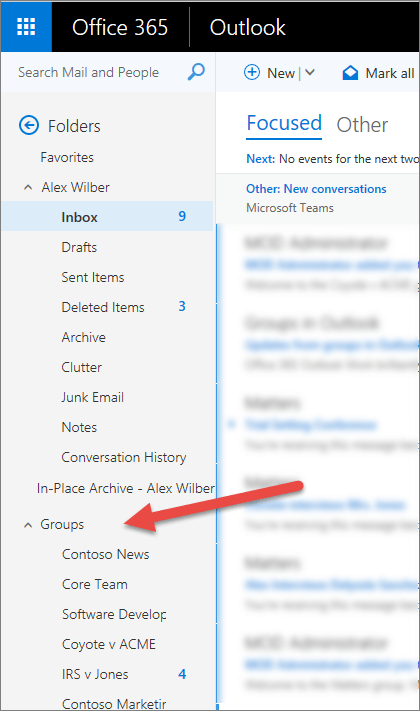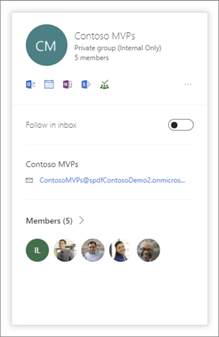Last reviewed December 2nd, 2022
Microsoft 365 Groups is a service that works with the Microsoft 365 tools you use already so you can collaborate with your teammates when writing documents, creating spreadsheets, working on project plans, scheduling meetings, or sending email.
This article will help introduce you to what groups are, and give you some helpful links to the next steps.
|
For the latest news and videos about Microsoft 365 Groups see Office Blogs |
Tips:
-
If you're looking for information on using Outlook contact groups to send email to a list of people - such as a group of friends - see Create a contact group or distribution list in Outlook for PC.
-
To learn about Microsoft Family Safety and how a family group helps you stay connected with your family members and keep them safe on Windows 10, Xbox devices, and Android devices, see Microsoft family group.
What are Microsoft 365 Groups?
Groups in Microsoft 365 let you choose a set of people that you wish to collaborate with and easily set up a collection of resources for those people to share. Resources such as a shared Outlook inbox, shared calendar or a document library for collaborating on files.
You don’t have to worry about manually assigning permissions to all those resources because adding members to the group automatically gives them the permissions they need to the tools your group provides. Additionally, groups are the new and improved experience for what we used to use distribution lists or shared mailboxes for.
Tip: For information on upgrading your traditional distribution lists to Microsoft 365 Groups, see Why you should upgrade your distribution lists to groups in Outlook.
Which kind of group should you create?
While you’re considering the options, it’s important to remember that one size rarely fits all. Different teams may prefer to work different ways and Microsoft 365 has the tools to enable collaboration in whatever form your teams prefer.
If your team prefers to collaborate via email and needs a shared calendar: Create a Microsoft 365 Group in Outlook.
If your team wants to collaborate in a persistent chat environment or use embedded apps: Create a Microsoft Team.
If you want to create a large, open, discussion forum for your company - for example for executive-level announcements and discussions: Create a group in Yammer.
You can create Microsoft 365 Groups from a variety of tools including Outlook, Outlook on the web, Outlook Mobile, SharePoint, Planner, Teams and more. Which tool you choose to start from depends on what kind of group you're working with. For example, at Microsoft we tend to start from Outlook when we're creating a Group organized around email and calendar. If the Group is for company-wide communication we tend to start with Yammer. For chat-based collaboration, we'd start our Group from Microsoft Teams.
When creating a group you'll need to decide if you want it to be a private group or a public group. Content in a public group can be seen by anybody in your organization, and anybody in your organization can join the group. Content in a private group must be seen by the members of the group and people who want to join a private group have to be approved by a group owner.
Note: Currently, groups created from Outlook on the web are private by default.
Neither public groups nor private groups can be seen or accessed by people outside of your organization unless those people have been specifically invited as guests.
For more information on changing your groups from Public to Private (or vice-versa), see Make Microsoft 365 groups public or private.
Owners, Members and Guests
Group owners are the moderators of the group. They can add or remove members and have unique permissions like the ability to delete conversations from the shared inbox or change different settings about the group. Group owners can rename the group, update the description or picture, and more. If you're familiar with SharePoint roles, then a group owner is a site collection admin.
Tip: It's best practice to have at least two owners for a Group, if you can. That way if one owner is unavailable the other can make changes to the Group.
Group members are the regular users in your organization who use the group to collaborate. They can access everything in the group but can't change group settings. In the SharePoint world they are site members. For information about adding or removing group members, see Add and remove group members in Outlook.
Guests are like group members, but they are outside your organization. By default, your users can invite guests to join your group, and you can control that setting. For more information, see Guest access in Microsoft 365 groups.
Select the type of Groups you want to use:
If you prefer the shared inbox mode of collaboration, then the groups experience in Outlook is for you. By creating a group in Outlook, you’ll get:
-
Shared Inbox– For email conversations between your members. This inbox has an email address and can be set to accept messages from people outside the group and even outside your organization, much like a traditional distribution list
-
Shared Calendar – For scheduling events related to the group
-
SharePoint Document Library– A central place for the group to store and share files
-
Shared OneNote Notebook – For gathering ideas, research, and information
-
SharePoint Team Site– A central repository for information, links and content relating to your group
-
Planner– For assigning and managing project tasks among your group members
You don’t have to manually create any of those resources; creating the group automatically creates them for you and assigns the necessary permissions for your group members so they can start using them right away.
You can access these resources through the familiar Microsoft Outlook desktop client (2016 or newer), via Outlook on the web, via Outlook 2016 for Mac (shared inbox only), or via Outlook mobile. You'll find your Microsoft 365 Groups in the navigation pane on the left in Outlook desktop or on the Web.

With the new Microsoft 365 Groups hover card, you have quick access to shared group resources. Just hover over a group name in Outlook on the web or SharePoint.

The newest part of our collaboration story is Microsoft Teams. Microsoft Teams is the inner loop for your team – a persistent, chat-based workspace where you can have informal, real-time, conversations around very focused topics or specific sub-groups within the group.
Yammer brings the enterprise social experience to your collaboration. It helps you make new connections and discoveries across your organization. It can help you communicate and discuss ideas company-wide or around common interest areas.
By creating a Microsoft 365 connected group in Yammer, you'll get:
-
Yammer Group – A common place to have conversations and share information
-
SharePoint Document Library – A central place for the group to store and share files
-
Shared OneNote Notebook – For gathering ideas, research, and information
-
SharePoint Team Site – A central repository for information, links and content relating to your group
-
Planner – For assigning and managing project tasks among your group members
You can access these tools through Yammer in your browser or using the Yammer app on your iOS, Android or Windows Phone device.
After a Group outlives its intended purpose, you can delete it to free up system resources and to remove the group from being listed or displayed. See: Delete a group. If you don't want to have to remember to delete outdated groups your administrator can set expiration policies that will cause old groups to expire and be removed automatically after a specified period of time. See: Microsoft 365 Group Expiration Policy.
Note: The content on this tab is intended for administrators.
There are three primary models of provisioning Microsoft 365 Groups: Open, IT-led, or Controlled. Each has its own advantages.
|
Model |
Advantages |
|---|---|
|
Open (default) |
Users can create their own groups as needed without needing to wait for, or bother, IT |
|
IT-led |
Users request a group from IT. IT can guide them in selecting the best collaboration tools for their needs |
|
Controlled |
Group creation restricted to specific people, teams, or services (See: Control who can create Microsoft 365 Groups) |
If you want to control how your Microsoft 365 Groups are named, you can use naming policy to force Group names to adhere to certain standards, including prefixed or suffixes, as well as blocking objectionable names. See Microsoft 365 Groups Naming Policy for more information.
Every group has at least one owner that can add or remove members and do some basic curation of the group and its content. Usually the owner does that in Outlook. See: Add and remove group members in Outlook. If a group's owner (or owners) leaves the organization for any reason, the administrator can assign a new owner to the group. See Assign a new owner to an orphaned group.
Additionally, if you have Exchange Online Administrator permissions you can administer your groups from the Microsoft 365 Admin Center (See Manage Group membership in the Microsoft 365 admin center) or from PowerShell (See Manage Microsoft 365 Groups with PowerShell.
There may come a time when you want to delete a group from your tenant. For information on how to delete a group see: Delete a group. If a group is accidentally deleted, admins can restore that group for up to 30 days. See: Restore a deleted Microsoft 365 Group.
If you prefer a more automated way to manage the lifecycle of your Microsoft 365 Groups, you can use expiration policies to expire groups at a specific time interval. The group's owners will get an email 30, 15, and 1 day before the group expiration that allows them to easily renew the group if it's still needed. See: Microsoft 365 Group Expiration Policy.
Group Limits
|
Maximum... |
Value |
|
Owners per group |
100 |
|
Groups a user can create |
250 |
|
Groups an admin can create |
Up to default tenant limit of 500K |
|
Number of members |
More than 1,000, though only 1,000 can access the Group conversations concurrently. Users might notice delays when accessing the calendar and conversations in very large groups in Outlook |
|
Number of Groups a user can be a member of |
1,000 |
|
File storage |
1 Terabyte + 10 GB per subscribed user + any additional storage purchased. You can purchase an unlimited amount of additional storage. |
|
Group Mailbox size |
50 GB |
The default maximum number of groups that an Microsoft 365 organization can have is currently 500,000.
If you are planning to use the feature "Group Writeback" from Azure Active Directory Connect tool, the maximum length is 448 characters related to the "Description" attribute.
For more information on SharePoint Online storage see SharePoint Online Limits and SharePoint Online software boundaries and limits.
Managing your Microsoft 365 Groups is more effective when you have actionable information about Groups usage. The Microsoft 365 Admin Center has a reporting tool that can let you see information such as storage use, how many active Groups you have, and even how your users are using the Groups. See: Microsoft 365 Reports in the admin center for more information.
Microsoft 365 Groups gives you a number of tools for compliance, information protection, and eDiscovery.










